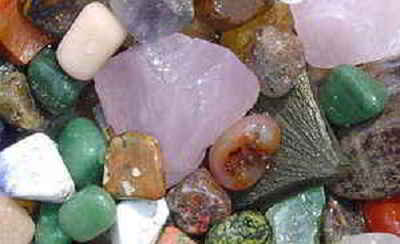Nebraska State Gemstone
Blue Agate (Blue chalcedony)

(SiO2 - Silicon Dioxide)
Adopted on March 1, 1967.
Blue chalcedony, commonly called the blue agate, was named Nebraska's state gemstone by legislative action in 1967. A pale stone, blue chalcedony, sometimes a dark internal form with bands of blue and white and often has a colorless streak. Blue agates often are used to make jewelry.
Blue Agate: Nebraska State Gemstone or Gem

Blue Agate has been found in place in wind-deposited claystones in the Chadron Formation of Oligocene Age in Sioux and Dawes counties. These gems have been found in colors other than blue and the large oval stone is a doublet with a blackened back to highlight the plumes in this material. Chalcedony is found in many deposit forms. Stalactite growths of the mineral are seen in numerous places and often assume fantastic shapes and forms. Chalcedony also may replace materials such as wood. The blue agate can be found in northwestern Nebraska. The chalcedony probably originated from silica that was freed when devitrification (changing from a glassy to a crystalline state) of wind-blown volcanic ash took place. The chalcedony appears to have formed in or near sources of alkaline water.
On Nebraska's centennial, the governor signed a bill designating blue chalcedony, commonly called the blue agate, as Nebraska's official state gemstone. The Blue Agate became the state gem on March 1, 1967 (Nebraska's Centennial).
Meaning and Uses of Blue Chalcedony
Agate - from the Greek 'achates' - is the old name of a Sicilian river, rich in precious stones of variegated colours. The richness of blue has a therapeutic, relaxing effect on the nervous system. It evokes shades of the sea and maternal warmth and protection.

Blue Chalcedony is an excellent crystal for public speakers and those who speak for a living. Lawyers and political speakers might benefit from touching this stone to the tip of their tongue while listening to their opponents to enhance their counter arguments.
Actors might rub it against their lips and throat, while singers may drink a glass of water in which Chalcedony has soaked for an hour before going on stage. Wearing this crystal around the neck helps overcome stage fright and the fear of public speaking.
Chalcedony was considered a sacred stone by the Native American Indians, using it to promote stability during their ceremonial activities. It is still in use today for meditations, and as a pathway for receiving successful thought transmissions.
Nebraska Law
The law designating the blue agate as the official Nebraska state gem stone is found in the Nebraska Statutes, Chapter 90 (Special Acts) Section 90-108.
Chapter 90 ? 90-108
90-108. State gem; blue agate.
The chalcedony stone, known as blue agate, is hereby declared the state gem stone of Nebraska.
Source
Laws 1967, c. 608, § 1, p. 2057;
R.R.S.1943, § 84-725.
General Quartz Information
Chemical Formula: SiO2
Composition: Molecular Weight = 60.08 gm
Silicon: 46.74 % Si 100.00 % SiO2
Oxygen: 53.26 % O
Total: 100.00 %
Empirical Formula: (SiO2)
Environment: Sedimentary, metamorphic, and igneous rocks.
IMA Status: Approved IMA 1962
Locality: Found world wide
Name Origin: From the German "quarz", of uncertain origin
Minerals, & Gems

Gemstone, Minerals, Rocks







